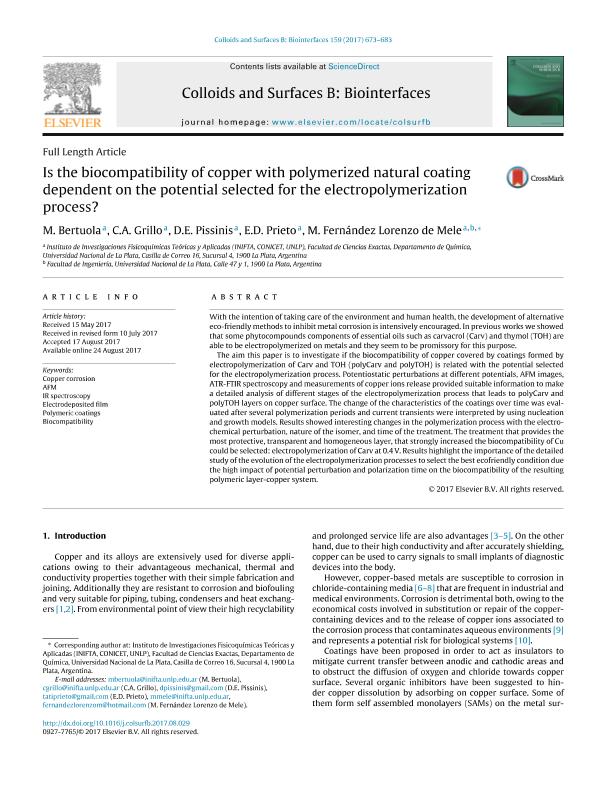Mostrar el registro sencillo del ítem
dc.contributor.author
Bertuola, Marcos

dc.contributor.author
Grillo, Claudia Alejandra

dc.contributor.author
Pissinis, Diego Ezequiel

dc.contributor.author
Prieto, Eduardo Daniel

dc.contributor.author
Fernandez Lorenzo, Monica Alicia

dc.date.available
2018-11-08T14:54:26Z
dc.date.issued
2017-11
dc.identifier.citation
Bertuola, Marcos; Grillo, Claudia Alejandra; Pissinis, Diego Ezequiel; Prieto, Eduardo Daniel; Fernandez Lorenzo, Monica Alicia; Is the biocompatibility of copper with polymerized natural coating dependent on the potential selected for the electropolymerization process?; Elsevier Science; Colloids and Surfaces B: Biointerfaces; 159; 11-2017; 673-683
dc.identifier.issn
0927-7765
dc.identifier.uri
http://hdl.handle.net/11336/63966
dc.description.abstract
With the intention of taking care of the environment and human health, the development of alternative eco-friendly methods to inhibit metal corrosion is intensively encouraged. In previous works we showed that some phytocompounds components of essential oils such as carvacrol (Carv) and thymol (TOH) are able to be electropolymerized on metals and they seem to be promissory for this purpose. The aim this paper is to investigate if the biocompatibility of copper covered by coatings formed by electropolymerization of Carv and TOH (polyCarv and polyTOH) is related with the potential selected for the electropolymerization process. Potentiostatic perturbations at different potentials, AFM images, ATR-FTIR spectroscopy and measurements of copper ions release provided suitable information to make a detailed analysis of different stages of the electropolymerization process that leads to polyCarv and polyTOH layers on copper surface. The change of the characteristics of the coatings over time was evaluated after several polymerization periods and current transients were interpreted by using nucleation and growth models. Results showed interesting changes in the polymerization process with the electrochemical perturbation, nature of the isomer, and time of the treatment. The treatment that provides the most protective, transparent and homogeneous layer, that strongly increased the biocompatibility of Cu could be selected: electropolymerization of Carv at 0.4 V. Results highlight the importance of the detailed study of the evolution of the electropolymerization processes to select the best ecofriendly condition due the high impact of potential perturbation and polarization time on the biocompatibility of the resulting polymeric layer-copper system.
dc.format
application/pdf
dc.language.iso
eng
dc.publisher
Elsevier Science

dc.rights
info:eu-repo/semantics/openAccess
dc.rights.uri
https://creativecommons.org/licenses/by-nc-nd/2.5/ar/
dc.subject
Copper Corrosion
dc.subject
Afm
dc.subject
Ir Spectroscopy
dc.subject
Electrodeposited Film
dc.subject
Polymeric Coating
dc.subject
Biocompatibility
dc.subject.classification
Recubrimientos y Películas

dc.subject.classification
Ingeniería de los Materiales

dc.subject.classification
INGENIERÍAS Y TECNOLOGÍAS

dc.subject.classification
Otras Biotecnologías de la Salud

dc.subject.classification
Biotecnología de la Salud

dc.subject.classification
CIENCIAS MÉDICAS Y DE LA SALUD

dc.subject.classification
Biotecnología Industrial

dc.subject.classification
Biotecnología Industrial

dc.subject.classification
INGENIERÍAS Y TECNOLOGÍAS

dc.title
Is the biocompatibility of copper with polymerized natural coating dependent on the potential selected for the electropolymerization process?
dc.type
info:eu-repo/semantics/article
dc.type
info:ar-repo/semantics/artículo
dc.type
info:eu-repo/semantics/publishedVersion
dc.date.updated
2018-10-22T22:31:53Z
dc.journal.volume
159
dc.journal.pagination
673-683
dc.journal.pais
Países Bajos

dc.journal.ciudad
Amsterdam
dc.description.fil
Fil: Bertuola, Marcos. Consejo Nacional de Investigaciones Científicas y Técnicas. Centro Científico Tecnológico Conicet - La Plata. Instituto de Investigaciones Fisicoquímicas Teóricas y Aplicadas. Universidad Nacional de La Plata. Facultad de Ciencias Exactas. Instituto de Investigaciones Fisicoquímicas Teóricas y Aplicadas; Argentina
dc.description.fil
Fil: Grillo, Claudia Alejandra. Consejo Nacional de Investigaciones Científicas y Técnicas. Centro Científico Tecnológico Conicet - La Plata. Instituto de Investigaciones Fisicoquímicas Teóricas y Aplicadas. Universidad Nacional de La Plata. Facultad de Ciencias Exactas. Instituto de Investigaciones Fisicoquímicas Teóricas y Aplicadas; Argentina
dc.description.fil
Fil: Pissinis, Diego Ezequiel. Consejo Nacional de Investigaciones Científicas y Técnicas. Centro Científico Tecnológico Conicet - La Plata. Instituto de Investigaciones Fisicoquímicas Teóricas y Aplicadas. Universidad Nacional de La Plata. Facultad de Ciencias Exactas. Instituto de Investigaciones Fisicoquímicas Teóricas y Aplicadas; Argentina
dc.description.fil
Fil: Prieto, Eduardo Daniel. Consejo Nacional de Investigaciones Científicas y Técnicas. Centro Científico Tecnológico Conicet - La Plata. Instituto de Investigaciones Fisicoquímicas Teóricas y Aplicadas. Universidad Nacional de La Plata. Facultad de Ciencias Exactas. Instituto de Investigaciones Fisicoquímicas Teóricas y Aplicadas; Argentina
dc.description.fil
Fil: Fernandez Lorenzo, Monica Alicia. Consejo Nacional de Investigaciones Científicas y Técnicas. Centro Científico Tecnológico Conicet - La Plata. Instituto de Investigaciones Fisicoquímicas Teóricas y Aplicadas. Universidad Nacional de La Plata. Facultad de Ciencias Exactas. Instituto de Investigaciones Fisicoquímicas Teóricas y Aplicadas; Argentina. Universidad Nacional de La Plata. Facultad de Ingeniería; Argentina
dc.journal.title
Colloids and Surfaces B: Biointerfaces

dc.relation.alternativeid
info:eu-repo/semantics/altIdentifier/url/http://www.sciencedirect.com/science/article/pii/S0927776517305441
dc.relation.alternativeid
info:eu-repo/semantics/altIdentifier/doi/http://dx.doi.org/10.1016/j.colsurfb.2017.08.029
Archivos asociados
